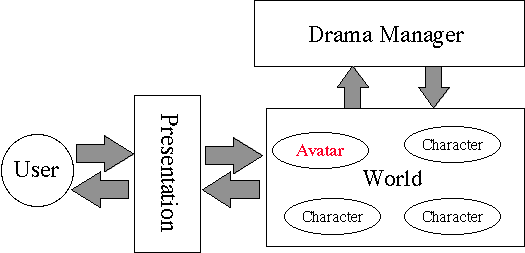
The Oz interactive drama architecture (Mateas 1997).
This reformulated poetics more closely mirrors many existing interactive drama system architectures than its predecessor. Such architectures tend to share the same (generally implied) medium of computer software. Within this software medium, interactive drama systems tend to include one or more separate modules for handling action, character, setting, and manner, though often by different names.
Action--the events of the story--is usually guided or produced by an agent called a director, drama manager, game master, narrator, scene manager, or story generator. Characters include agents or cast members under the control of the drama system. An avatar or player character is the character under the control of the user. The setting--those locations and props of the dramatic world--might be collectively called the story world, environment, stage, or theater. Finally, the manner, or discourse, layer of the system handles the details of presentation to the user, as well as receiving interaction from the user. This component may be called the narrator, presenter, renderer, theater, or interface.
Certain terms, such as narrator and theater, appear under more than one category. Additionally, some projects subdivide or combine certain elements depending on their needs.
With this proposed poetics framework as a foundation, we can examine existing interactive drama architectures for similarities.
The Oz Project has followed a practically identical model (Mateas 1997). This is also the model used by Chris Fairclough's (2005) OPIATE project.
These system components map to the poetics levels as follows:
| Poetics | Oz Project |
|---|---|
| Action | Drama Manager |
| Story World | World (including Characters) |
| Manner | Presentation |
Not all architectures map as cleanly to the new poetics as does the Oz architecture. For instance, Mateas and Stern's Facade uses the following architecture:
At first glance, it may seem that Facade's Natural Language Processing module provides the manner layer. However, this processing is done only for textual input, not output. When a player enters a text string, the system translates this surface text into a discourse act.1 These discourse acts have nothing to do with manner or discourse in terms of the poetics; rather, they are events in the story world that formally prompt character reactions.
Facade breaks action management into beat selection and modeling the story so far.
| Poetics | Facade |
|---|---|
| Action | Drama Manager + Story Memory |
| Story World | Story World (including Characters) |
| Manner | [not shown] |
The Virtual Storyteller project aims at developing an animated character that narrates generated stories.
Though they mention characters' knowledge of their "virtual environment", they do not include this virtual world in their model. The characters' actions are directed by the "director" to produce a story. This project's "narrator" then rearranges the events of the story, and the "presenter" relates them to the user. This places these two components at the level of manner.
| Poetics | Virtual Storyteller |
|---|---|
| Action | Director |
| Story World | Characters; ["virtual environment" (setting) not shown] |
| Manner | Narrator + Presenter |
Spierling et al. (2002) propose an architecture comprised of four hierarchical levels. The output of each level provides input for the one below it--much as the poetics describes formal cause working downward through the levels.
Spierling et al. have divided story management into two levels: the management of the overall general (functional/morphological) structure and the construction of specific, instantiating scenes. The Character Conservation Engines also hints at a model of setting to support stage direction.
| Poetics | Spierling et al. |
|---|---|
| Action | Story Engine + Scene Action Engine |
| Story World | Character Conversation Engines |
| Manner | Actor Avatar Engines |
As we have seen, the revised poetics provides a good overview of interactive narrative elements. Each project here uses different terms and different divisions between architecture components. Often a project may include multiple components for a single level of the poetics. This generally indicates what aspects the project is most interested in exploring. For instance, Facade is focused on story management and so has two components at the action level. On the other hand, the Virtual Storyteller is particularly interested in the narration of stories and so they have two components at the manner level.
A project may also combine two elements into a single architecture component or fail to mention an element in their overview if it plays a marginal role in that project's particular focus.
Overall, it seems the revised poetics can at least inform the design of system architectures--which is not something that can be easily claimed of the previous version.
|
Argax Project : Dissertation :
A Rough Draft Node http://www2.hawaii.edu/~ztomasze/argax |

|
Last Edited: 08 Apr 2011 ©2006 by Z. Tomaszewski. |